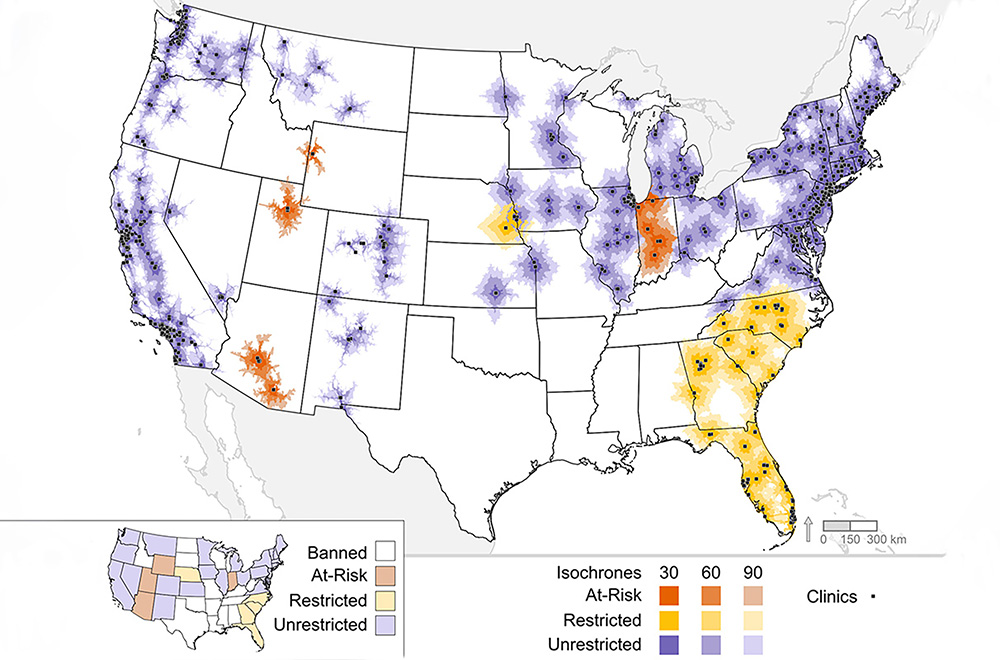Quick Summary
- Use of geospatial technology and analysis is newer in field of medicine.
- Study compared census data to locations of 750 abortion care facilities.
- Road distance and speed limits were used in calculations.
One year after the Dobbs decision, nearly 42% of U.S. women of reproductive age have to drive 30 minutes or more to reach an abortion care facility, according to a study co-authored by researchers from the University of California, Davis, and Washington State University.
The data is up to date as of June 2, and researchers predicted the percentage of women having to drive 30 minutes or more would rise to more than 53% if other state bills under consideration are passed.
The study found more than 29% of women didn’t have access to a facility within a 60-minute drive and nearly 24% lacked access even within a 90-minute drive. Those figures would jump to almost 46% and 43% respectively if new restrictions are passed.
While the 2022 Dobbs decision overturning Roe v. Wade created a patchwork of abortion restrictions across the nation, the researchers found state laws did not necessarily determine the procedure’s availability.
"Access does not simply rely on states' abortion laws, but rather is a product of geographic access, legislative access and health care professional availability," the authors wrote. "Even within a state where abortion is not restricted, the time it takes for a person to travel to an abortion facility can vary widely."
Earlier studies have estimated distances to care, but this research used geospatial, or location-based, science to focus on the real drives women would have to make. “Driving time, rather than distance, is a common way people judge how easy it is to get somewhere,” said Michele Tobias, a geospatial data specialist at the UC Davis DataLab and co-author of the study.
“The use of geospatial technology and analysis in the field of medicine is a growing area of interest,” Tobias said.
The study is scheduled to be published in the September issue of the journal Obstetrics and Gynecology, but editors deemed it so critical they have already published it online.
Researchers at the DataLab compared census data for women ages 15-49 to locations of 750 abortion care facilities, gathered from lists available online to mimic what a person might use to search for a provider.
Tobias said the DataLab team developed computer code that used the road distance and the speed limit to calculate how long it would take to drive to a given clinic location. The analysis used isochrones, or map lines, to show the travel time areas.

“This study highlights that abortion access is about more than laws,” said Dr. Dawn Kopp of Washington State University’s Elson S. Floyd College of Medicine and senior author on the study. “It’s about more than the state you reside in because people are allowed to cross state borders for medical care. There are a lot of other factors at play.”
The lack of access has potential serious health consequences as other research has found an increase in maternal and neonatal mortality in states with more abortion restrictions.
These risks have a greater effect on people with lower incomes, the authors said, since the cost of travel and time off work can put the abortion out of reach for people in places like Texas and states without providers in neighboring areas.
The researchers considered telehealth services, as many early pregnancy abortions are now done through medication taken at home. However, researchers could not estimate their geographical reach. They also noted the barriers to telehealth including finding follow-up care in areas where abortion is illegal. Many states have also enacted legislation to ban or restrict telehealth use for abortion.
Media Resources
Media contacts:
-
Julia Ann Easley, UC Davis News and Media Relations, jaeasley@ucdavis.edu 530-219-4545
-
Michele Tobias, UC Davis DataLab, mmtobias@ucdavis.edu
-
Sara Zaske, WSU News and Media Relations, sara.zaske@wsu.edu, 509-335-4846
